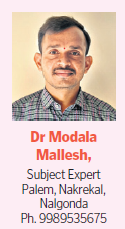Topics you should know to score high marks in biological sciences
Hyderabad: The study of life, living organisms, life cycles of various species of organisms, and the environments they live in – these broadly come under the biological sciences. From single cell organisms to well-developed species, from various plant species to aquatic (marine) life to human beings, everything living becomes part of the studies categorised as […]
Published Date - 12 June 2022, 11:00 PM
Hyderabad: The study of life, living organisms, life cycles of various species of organisms, and the environments they live in – these broadly come under the biological sciences. From single cell organisms to well-developed species, from various plant species to aquatic (marine) life to human beings, everything living becomes part of the studies categorised as biological sciences.
Here are some sample questions to help you understand the basics of biology.
Q. Match the following & choose the correct match
List-I List-II
1. Muscle fascicle i. Epimysium
2. Nerve ii. Endoneurium
3. Nerve fascicle iii. Perineurium
4. Nerve fibre iv. Perimysium
5. Muscle v. Epineurium
1 2 3 4 5
a. iv v iii ii i
b. i v iii iv ii
c. iv iii v ii i
d. iv v ii iii i
Ans: a
Q. Which type of white blood cells are concerned with the release of histamine & natural anticoagulant?
a. Monocytes
b. Neutrophils
c. Basophils
d. Eosinophils
Ans: c
Q. The tissue which covers the external surface of the animal body & internal surface of visceral organs is:
a. Epithelial tissue
b. Connective tissue
c. Adipose tissue
d. None of these
Ans: a
Q. Ectoderm gives rise to:
a. Cornea, heart, bronchi, dentine
b. Adrenal cortex, tongue, liver, retina
c. Lungs, adrenal medulla,dermis, thyroid
d. Enamel of teeth, nails, adrenal medulla, hair
Ans: d
Q. Smooth muscles are:
a. Involuntary, cylindrical, striated
b. Involuntary, fusiform, non-striated
c. Voluntary, multinucleated, cylindrical
d. Voluntary, spindle-shaped, uninucleated
Ans: b
Read the following table
Bone(s) Type Formed by ossification of
1. Limb bones – Endochondral bones – Gristle
2. Most cranial bones – Replacing bones – Mesenchyma
3. Patella – Sesamoid bone – Ligament
4. Oscordis – Visceral bone – Soft tissue in the heart of ruminant
The correct combinations are
a. 1 & 4
b. 3 & 4
c. 1 & 2
d. 2 & 4
Ans: a
The function of gap junction is to
a. Facilitate communication between adjoining cells by connecting the cytoplasm for rapid transfer of ions, small molecules & some large molecules.
b. Performing cementing to keep neighbouring cells together
c. Stop substances from leaking across a tissue
d. Separate two cells from each other
Ans: a
The totipotent cell can form a
a. Bud
b. Cell membrane
c. Cell organelle
d. Complete new organism
Ans: d
Which of the following is always absent in prokaryotic cells?
a. DNA
b. Cell wall
c. Ribosomes
d. Mitochondria
Ans: d
Q. Read the following statements
1. They help in respiration
2. They help in cell wall formation
3. They help IN DNA Replication
4. They increase surface area of plasma membrane.
Which of the following prokaryotic structures has all the above roles?
a. Ribosomes
b. Mesosomes
c. Lysosomes
d. Polysomes
Ans: b

Now you can get handpicked stories from Telangana Today on Telegram everyday. Click the link to subscribe.
Click to follow Telangana Today Facebook page and Twitter .